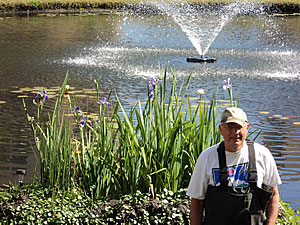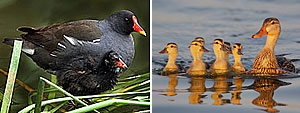 |
||||||||

Adopt-A-Pond: Is Opportunity Knocking at Your Front Door?
By Ernie Franke

Most folks think I have a background in ecology (I'm actually an electrical engineer). After pouring through nature books to identify weeds and waterfowl, you get to know them quite well.
Most of us, at some point in our lives, have wondered just how much difference we can make in the world. That's what happened with the pond just outside my front door at The Shores of Long Bayou in St. Petersburg.
Although I call it "my pond," it really is a stormwater retention facility designed to capture contaminants from lawns, roads and parking lots before they enter Long Bayou or sink into the underground aquifer. The pond had been neglected for many years, and required chemical controls to contain invasive bulrush and cattail plants. Condo owners didn’t want "raw" nature, preferring something closer to a golf-course setting, but the pond had gravitated more to an "Everglades" look. Yes, we even had an alligator in it!
Now that I’m retired, I had the time and energy to devote to a project such as getting the pond back to its natural state. Make no mistake, it was a lot of work, but like everything else in life — "Isn’t anything of value a result of passionate work?"
Community Involvement Works Both Ways
The first step in restoring our pond was to get the backing of our homeowners association, its wetlands advisory committee, and the regional water management district. Because it was going to beautify the neighborhood and increase property values, management was all for it — as long as we didn't want much money. We did discover that condo folks are more than happy to buy plants, because it contributes to the morale of the development as well as increasing property values.
People feel a part of a project when they know what’s going on and why. Because transforming a pond is a long-term affair, it’s important to transfer your vision of how the pond will look in the future. I publish a quarterly report that's posted on the board of each building. It lists the accomplishments of the last quarter, but more importantly, outlines planned activities for the future.
The report is in a bullet format so it's easy to read and it explains why I do certain things. For instance, we built some islands by scooping up the muck from the bottom. Some folks thought this was a lot of work, but the islands serve several purposes — a place to raise plants without the threat of invasive weeds as well as serving as a nesting place for waterfowl, unreachable by humans and other predators.
It should also address who has oversight over the project and emphasize the importance of rules, such as the requirement for using Florida native plants. Because the pond is part of the greater multi-county watershed and we live in an ecosystem where exotic plants and animals take over, we are only allowed to plant native, non-invasive plants.
Native plants are not always showy. They come with descriptive names though, such as mexicana (yellow) and fragrant (white) water lily, pickerelweed (the pretty purple-spiked flower), spatterdock (the lily with yellow flowers), duck potato (with white flowers on stalks) and southern blue flag, a native species of the well-known iris.
At first we were a receptor of plants, but now we serve as a source for other ponds, supplying plants chosen for pollution-filtering characteristics and contributions to wildlife. We've supplied water lilies, pickerelweed and canna plants for four other ponds in our complex and I'm working with another building to develop a plan to rejuvenate their pond. We also have plenty of yellow lilies and horse-tail reed available to anyone who can use them in their pond.
The Delights of "Owning" Your Own Pond

Have I shown you my baby moorhens? Imagine the joy of watching your baby ducklings hatch. You guard and enjoy them as only a grandparent could. Just as you would enjoy a vegetable garden, a pond can yield hours of delight as you see your pond come alive. And – the animals are a joy rather than a nuisance!
Along with looking good for the people who live nearby, a top priority for our pond is providing a haven for waterfowl. Across Florida, there has been significant habitat lost to development. I have taken what’s called an "adaptive management strategy" to restoring the pond, a practice common in conservation projects. Small changes are introduced and then monitored for effect, allowing the plan to evolve based on the success or failure of different aspects.
When I visit my doctor, he always asks "How much do you exercise each week?" He’s shocked when I say about 10 hours, but it's my hobby. Anything worthwhile comes with challenges. Make no mistake, restoring a pond is hard work, more at the start, then less on maintenance. It’s an all-over work-out too — bending, digging, weeding, walking. I would have to pay a monthly fee to receive the same work-out that I get for free at my "pond gymnasium."
It's also exercise with a purpose, an outcome that helps maintain my health, enhances my neighborhood and provides critical wildlife habitat. Working in the pond gives you a great chance to meet neighbors who know you as the "pond guy." You also get to watch the animals around you, especially during mating season. When baby black fluffballs follow their mama moorhen across the pond, you’ll find yourself proudly sharing photos of your "pond grandkids."
The Mechanics of Pond Balance

Native plants ring the pond, providing habitat for fish, birds and turtles.
Adopting a pond causes you to "really" look at other ponds more closely. What are the qualities you want in your pond? You imagine what some ponds could look like if they were adopted. It is a commitment. It’s also a two-edged sword. If it doesn’t succeed, it is evident to everyone. If it succeeds, it is a treasure.
I’ve discovered several secrets that have helped:
- Forming islands helps to provide a barrier to weeds while allowing me to devote each island to specific plants. It’s a matter of balance to achieve the right amount of plants and animals to sustain a mini-ecosphere.
- Be patient as it simply takes time. It will take several years to manually "undo" what has been chemically "done" for so many years. You can’t turn a neglected eyesore around in a few months.
- It also takes scheduling. It’s a waste to stock fish until cover has been provided. Water lilies have proven to be great, offering cover for fish hiding from herons and egrets, as well as a nursery area for the fish. They also filter sunlight and lower water temperature to decrease algae growth.
- Similarly you can’t expect birds to nest until you provide vegetated islands they need with food and protection from predators.
- Once you hit the "turning point," you'll see that everything builds onto something else. For example, large populations of snails eat algae to help keep the pond water clear and also serve as a food source for water fowl and turtles.
Hope Springs Eternal
Those of you who have had gardens know how it feels as Spring approaches. You eye the seed catalogues, dreaming of what your garden will look like. For the pond, you find yourself looking forward to spring blossoms, seeking out new plants, weeding, dividing plants and, of course, controlling algae. Just as it was with your garden, all your efforts won’t be successful. Some plants will fail, others will succeed. With summer comes algae growth. But just when it seems unbearable, temperatures drop and the algae growth subsides. It’s time to rest and plan for the next year.
Ernie Franke is an electrical engineer who retired from Raytheon in St. Petersburg and began working on "his pond" in October 2009. He's been so successful at The Shores that he has extra plants available for residents of other communities. Contact him via email at eafranke@tampabay.rr.com or call 727-393-8639.
Learn More!
Pinellas County Watershed Management: call 727-464-4425 or visit www.pinellascounty.org/environment/watershed/adopt-pond.htm.
Hillsborough County: call 813-635-5400 or visit www.hillsboroughcounty.org/publicworks/engineering/stormwater/adoptapond.cfm.
Pasco County: call 813-929-0114 or visit www.adoptapondpasco.org.
Funding for community ponds also is available through the Southwest Florida Water Management District's Community Education Grants. See related story.
